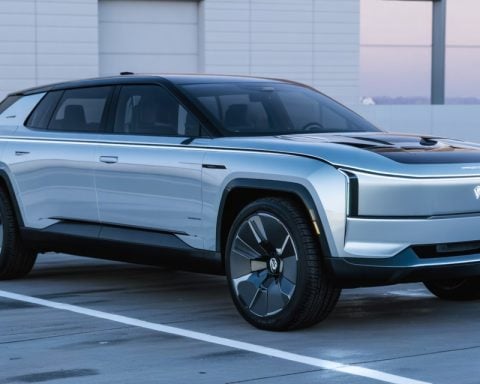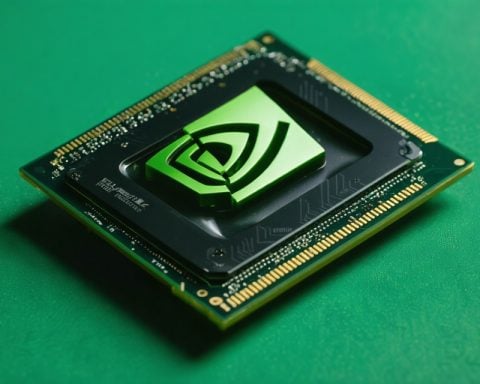- Nvidia faces scrutiny due to a disruptive AI model by Chinese start-up DeepSeek, questioning the need for its advanced chip technology.
- Tech giants, known as the “Magnificent Seven,” are investing heavily in AI infrastructure to consolidate their positions amidst market uncertainties.
- Microsoft leads the charge with an $80 billion investment, while Meta plans around $65 billion in capital expenditures.
- Alphabet and Amazon are collectively investing approximately $180 billion in AI, signaling an industry-wide commitment.
- Nvidia anticipates potential growth opportunities amid these investments but remains under market pressure based on upcoming financial guidance.
- Investors are advised to consider Nvidia’s alignment with AI investment trends, which could lead to a recovery in its stock value.
Emerging from the mist of stock market volatility, Nvidia finds itself in a tension-laden spotlight. Recently, a bold move by Chinese start-up DeepSeek disrupted the status quo by launching an AI model that rattled investors’ nerves. Claimed to be functioning on legacy architectures, its development strategy challenges the necessity of Nvidia’s cutting-edge chip offerings.
In this mire of uncertainty, big tech giants, dubbed the “Magnificent Seven,” are not just watching passively. They are fortifying their AI infrastructure stakes, signaling a broader trend of unwavering commitment despite the upheaval. Microsoft is leading with an impressive $80 billion investment in AI infrastructure, casting a significant ripple in the tech pond. Meta Platforms isn’t far behind, hinting at an equally robust $65 billion in capital expenditures to fortify its future. As if in a synchronized dance of technological ambition, Alphabet and Amazon collectively aim to funnel approximately $180 billion into AI development.
For Nvidia, this avalanche of spending heralds an opportunity—albeit one wrapped in uncertainty. As the company gears up to reveal its earnings, eyes will be peeled for subtle cues in financial guidance. An optimistic outlook could mean these tech behemoths see Nvidia’s advanced chip architectures as indispensable assets for their ambitious growth trajectories. However, any sign of wavering growth might suggest a more cautious pace of acquisitions.
Investors contemplating Nvidia’s stock must weigh these factors carefully. While timing an investment is a rarity for the seasoned, Nvidia’s alignment with big tech’s expansive AI investments suggests a potential rebound from recent dips. This AI arms race could well prove to be the tide that lifts Nvidia’s sails.
Nvidia’s Future in the AI Arms Race: What Investors Need to Know
How-To Steps & Life Hacks
For those looking to leverage Nvidia’s stock opportunities, consider these steps:
1. Stay Updated: Follow Nvidia’s earnings reports and news. This helps identify trends in their financial guidance and capital expenditure.
2. Diversify Investments: While Nvidia appears promising, balance your portfolio with other technology and AI stocks to minimize risk.
3. Monitor AI Developments: Keep an eye on the evolving AI technologies and their industry applications. This helps understand Nvidia’s technological relevance.
4. Evaluate Chip Needs: Assess how Nvidia’s chips are applied across different industries by reading market reports and industry analyses.
Real-World Use Cases
Nvidia’s chips are vital in various sectors. Here are a few real-world applications:
– Autonomous Vehicles: Providing the computational power for real-time decision making.
– Healthcare Imaging: Accelerating the analysis of medical images, leading to quicker diagnostics.
– Gaming: Enhancing graphics and performance through powerful GPUs.
– Financial Services: Supporting complex computational tasks for real-time data analysis and stock trading algorithms.
Market Forecasts & Industry Trends
The AI chip market is experiencing robust growth. According to Grand View Research, the global AI chip market size was valued at $10.41 billion in 2022 and is expected to grow at a CAGR of 37.5% from 2023 to 2030.
Reviews & Comparisons
Comparatively, Nvidia’s GPUs often outrank competitors like AMD and Intel in terms of performance and power efficiency. However, companies like Google and Amazon are developing in-house chips, which increases market competition.
Controversies & Limitations
Nvidia faces challenges from regulatory scrutiny, particularly concerning its acquisitions and international operations. The U.S-China trade war also poses risks, as any restrictions on tech exports could impact Nvidia’s sales.
Features, Specs & Pricing
Nvidia continues to innovate with its chipset offerings, such as the Ampere architecture which features high memory bandwidth and significant energy efficiency improvements. However, high-performance GPUs often come at a premium price point.
Security & Sustainability
Nvidia is actively enhancing the security features of its products and is committed to sustainability by improving energy efficiency across its chip designs. However, the environmental impact of semiconductor manufacturing remains a concern.
Insights & Predictions
The ongoing AI investments from major tech firms signal a promising future for Nvidia. However, external economic pressures may affect near-term growth. Experts predict that as AI models continue to grow in complexity, Nvidia’s advanced chips will play a critical role.
Pros & Cons Overview
Pros:
– Strong position in the AI chip market.
– Continuous innovation and R&D prowess.
– Strategic partnerships with tech giants.
Cons:
– High dependency on tech industry cycles.
– Potential geopolitical risks.
– Increasing competition from custom in-house AI chips produced by big tech firms.
Actionable Recommendations
– Research Extensively: Before investing, consider Nvidia’s influence in AI and related industries. Use industry reports and financial analyses.
– Leverage Tech ETFs: Consider technology ETFs that include Nvidia if looking for a more diversified investment approach.
By understanding Nvidia’s role in the broader AI industry, investors can make informed decisions. For more information about Nvidia, visit the official Nvidia website.


















